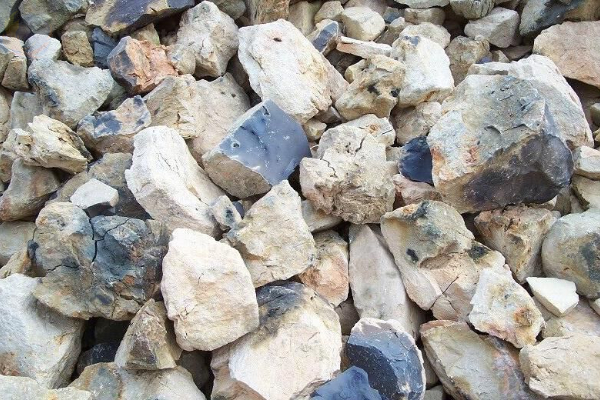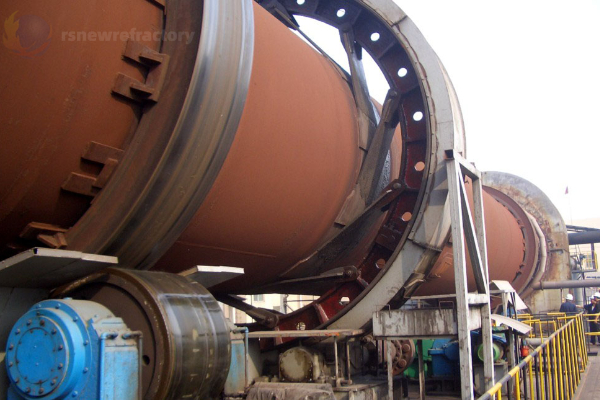The bauxite calcination process is a complex process in which raw bauxite is calcined at high temperatures (1200-1700℃) to produce calcined bauxite. As the calcination temperature increases and the holding time lengthens, the aluminum content increases, and the grade of the bauxite also increases.
Rotary kiln bauxite calcination process flow

Bauxite with an initial particle size of 300-500mm is crushed and then sent to a fluidized bed dryer for drying. It is then mixed with manganese powder and additives at a batching station, and fed into a grinding system equipped with a cyclone classifier to prepare raw material powder with a fineness of over 400 mesh. Using a new type of granulator developed by Zhengkuang Machinery, water is added to the raw material powder to form granules of the required size. The granules enter a dryer located at the kiln tail, where the waste heat from the kiln is used to reduce the moisture content of the granules. They are then screened and fed into a rotary kiln for calcination. The calcined ceramic proppant is cooled by a single-stage cooler and then screened using a cylindrical screen. The qualified granules of different sizes are packaged separately and shipped, while the unqualified granules are returned to the grinding system.
Crushing system
The bauxite entering the plant has a lump size of approximately 300-500mm and a moisture content of about 8%. After arriving at the plant, the bauxite is stored in a storage shed. The storage capacity is generally sufficient for about one month’s supply. A forklift loads the bauxite into the hopper, and a plate feeder evenly and continuously feeds it into a jaw crusher. After crushing, the particle size becomes 50-80mm, and then it is transported by a belt conveyor to an impact crusher, where the particle size is reduced to less than 20mm. The crushed bauxite is then stored in a buffer hopper.
Rotary kiln bauxite drying system
The crushed bauxite in the buffer silo is transported by belt conveyor and elevator to the circular silo at the top of the fluidized bed furnace. A weighing belt feeder is installed below the silo to ensure that the crushed bauxite enters the dryer evenly. The dried bauxite is then sent to the dry bauxite storage (batching silo), or it can be sent to the storage shed, where it is generally stored for about 5 days. The fluidized bed furnace generates hot flue gas at 800-900℃. Low-volatile coal is used as fuel. The crushed coal particles are 5-8mm in size and are fed into the fluidized bed furnace by a rotary feeder. An automatic temperature control system is used to control the feeding speed of the rotary feeder to stabilize the combustion temperature of the fluidized bed furnace. A bag filter is used to purify the exhaust gas from the dryer, ensuring that dust emissions meet the standards.

Ingredient station
Bauxite, manganese powder, and additives are used in the batching process. All materials are transported to the batching warehouse. A variable-speed belt weighing feeder is installed beneath the warehouse, and a microcomputer-based batching system automatically controls the proportioning of the materials. After proportioning, the materials are conveyed by a belt conveyor into the grinding system.
Grinding system
The grinding system adopts a closed-loop system, producing raw material powder with a fineness of over 500 mesh. A three-compartment tube mill is used. The classifier is an O-sepa type* vortex classifier, and the fineness of the product can be easily adjusted by changing the classifier’s rotation speed. The classified finished raw material powder is collected by a high-concentration air box pulse bag filter and then sent to the raw material silo.
Granulation system
The granulation process utilizes a new type of granulator developed by our company. This granulator features fast pellet formation speed, high efficiency, good sphericity, and clean production. After the raw materials are discharged from the raw material silo, they are transported by screw conveyors and elevators to the hopper at the top of the new granulator. A screw weighing feeder is used below the hopper to feed the raw materials into the granulator. The granulation water is metered and then added to the granulator. The ratio of raw materials to water can be adjusted. Inside the granulator, the raw materials and water form pellets under the action of high-speed rotating stirring rods and a low-speed rotating inner cylinder. After a certain period, granulation is completed, and the raw material pellets are discharged from the lower discharge pipe and fall onto a belt feeder. The raw material pellets are then transported to the kiln tail dryer.
Kiln tail drying system
The newly formed pellets contain approximately 15% moisture. Using the waste heat from the kiln exhaust gases, the pellets are dried in a dryer at the kiln outlet, reducing the moisture content to about 8% before entering the kiln for calcination. The dryer at the kiln outlet uses a counter-current flow system. A separate burner is installed at the hot air inlet of the dryer to provide hot air when the waste heat from the kiln exhaust gases is insufficient. The temperature of the kiln exhaust gas used in the dryer is approximately 500℃, and after passing through the dryer, the temperature drops to around 150℃, which is suitable for the operating conditions of the bag filter at the kiln outlet. The dried raw material pellets exiting the dryer are stored in an intermediate silo for use in the rotary kiln.
Rotary kiln system
The dried raw material granules are discharged from the intermediate silo and lifted to the kiln tail by an elevator. A vibrating screen separates the raw material granules into qualified and unqualified types. The qualified granules enter the rotary kiln for calcination, while the unqualified granules are returned to the grinding system. Inside the rotary kiln, the raw material granules gradually move towards the kiln head as the kiln rotates. In the calcination zone, at a temperature of 1300℃~1350℃, they are calcined into petroleum proppant ceramic sand. The ceramic sand then enters a single-drum cooler for cooling, and the secondary air from the cooler is fed into the rotary kiln.
Kiln tail dust collection system
A bag filter is used to purify the waste gas from the kiln tail (including the waste gas from the kiln tail dryer). A humidification tower is also installed at the kiln tail to cool the waste gas, reducing its temperature to the required level for the bag filter. The emission concentration from the bag filter can reach below 30 mg/Nm³, achieving compliant emissions and clean production.
Finished product system
The ceramic sand discharged from the cooling machine is conveyed to a vibrating screen, where it is separated into different particle sizes according to standard requirements and then transferred to different finished product silos. Electronic weighing scales are installed beneath the silos, and bags of finished product that meet the weight specifications are sealed by a bag-sealing machine and then stacked in the finished product warehouse, ready for shipment.
 영성그룹
영성그룹

위챗
wechat으로 QR 코드를 스캔하세요